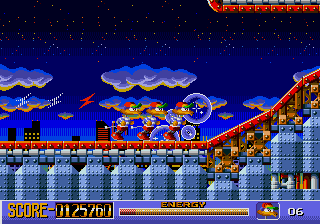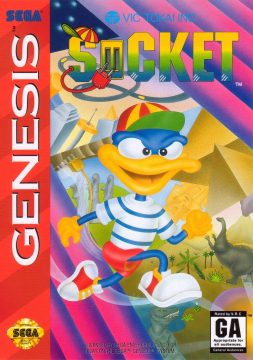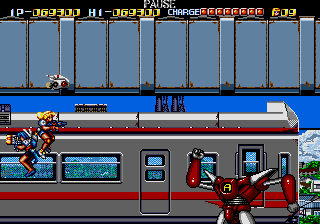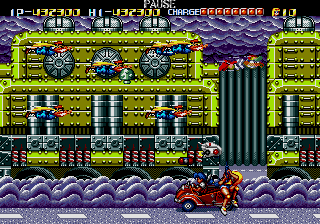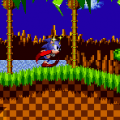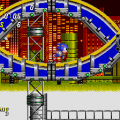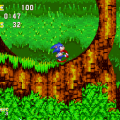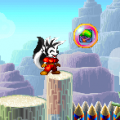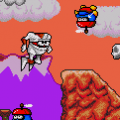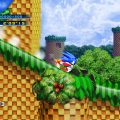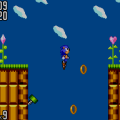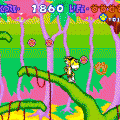It’s hard to deny the influence Sonic the Hedgehog had over the proliferation of mascot platformers in the 90s, starring animal characters who sometimes sported an attitude or upfront personality. But taking more inspiration than most is Vic Tokai’s Socket, where a non-nonsense animal runs at fast speeds across levels full of steep hills and winding curves. While that might be the most interesting thing about this game, it’s still a decent if unremarkable side-scroller.
In the distant future, the dastardly Time Dominator has been mucking up the flow of time by travelling to the past, stealing treasures and causing so much havoc that they’ve created a time warp. A special patrol has been set up to monitor and eliminate this warp, and they commission an android bird named Socket (or Minute in the Japanese version) to travel through time and put a stop to Time Dominator’s schemes.
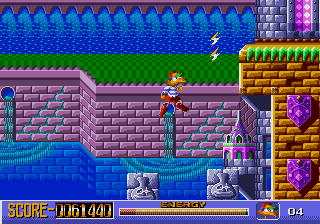
Socket is a 2D platformer that sees you running, jumping and kicking your way to the end of the level. Like Sonic, you gain speed by running down hills and lose speed going up them, though it’s not hugely vital beyond the handful of sections and levels that explicitly demand it. Being an android, and not a very energy efficient one apparently, Socket has a power meter that’s constantly draining. You’re encouraged to reach the level’s end before it runs out, but there’s plenty of electricity scattered around to ensure you’re not constantly rushing through stages.
There’s also other items to be found, such as extra lives, invincibility and shield power-ups, so it’s a good idea to slow down and even try out some of the many alternate routes that are on offer. While overall a linear game, many stages offer you different ways of reaching the end, whether they’re branching paths or secret doors that take you to one-off areas complete with unique graphics and challenges.
This allows for a good bit of variety, which can also be seen in the distinct obstacles featured in each world, such as the mine carts in Olein Cavern to the gravity-flipping tunnels of the distant Future. A couple of them are quite annoying, like Antiquity’s tediously slow underwater areas, but it’s an admirable attempt to keep things interesting throughout.
The same is true for how each of the game’s seven worlds feature three distinctly designated level types. High Speed stages see you running through topsy-turvy levels with speed boosters to help you clear some steep curves, Athletic areas slow things down and let you explore various routes on your way to the end, and Labyrinth levels put you through winding mazes to find the boss battle lurking behind a special door.
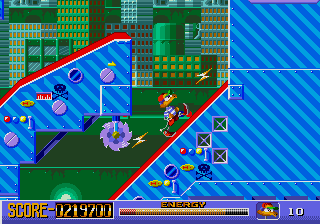
Labyrinth levels can be the trickiest of the bunch, with convoluted designs and roundabout routes making it quite easy to get lost and accidentally retrace your steps while trying to find the exit. It’s especially annoying when you can miss the one mid-level checkpoint whilst stumbling around, forcing you to take things from the top if you die. The added challenge and bottomless pits seen in the secret door areas exacerbate this, since you still respawn at the level’s start. On that note, you respawn at only half your health, which isn’t too bad but still adds some extra pressure when exploring the mazes.
At the very least the boss fights are courteous enough to respawn you outside their entrance if you reach them and then die (albeit at half-health). Although that’s not likely, as the boss battles are quick knockabout affairs where you can attack them whenever you like, even if you get hurt in the process. While they do get more difficult later on, it never becomes too overwhelming.
Socket in general has a low level of challenge, owing to the many power-ups you can find, the number of continues build up the more points you get, and the overall pleasantness of the controls. Trying to run up hills can be a bit sluggish, since it’s sometimes unclear how you’re meant to get enough momentum, but moving and jumping around is consistently dependable. That said, the lack of escalating challenge until the final levels means that there’s no major highs or lows, making the adventure feel flat and forgettable at times.
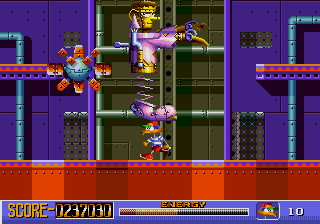
Perhaps this is also true for the presentation. The visuals are fairly solid, offering a largely smooth framerate (barring the odd drop when things get busy) and plenty of bright colorful landscapes, but they don’t make much of an impression outside of some pretty backgrounds. The soundtrack is more fondly remembered, composed by Fumito Tamayama, Yoko Kawashima, Shigenori Masuko, and Yasuyuki Hamada (who all composed for many games, but also worked together on Battle Mania: Daiginjou). Your adventure is punctuated with upbeat tunes that complement the mood of each area, and packed with some really great arrangements which make for an enjoyable listen on their own.
Socket also features a time trial mode where you can play the High Speed stages without enemies and try to reach the best time. The characters appear briefly in the second and fifth stage of Battle Mania: Daiginjou (released in between Socket’s American and Japanese releases), with Time Dominator appearing in one of their later forms.
Special thanks to Forneia for her help on figuring out how to approach writing this article.
